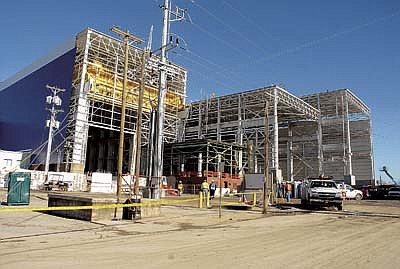Powerful additionsThe planned addition of more U.S. nuclear power plants could add hundreds of new jobs in the region* Alstom Power Turbomachines built a $280 million fabrication facility on Riverfront Parkway which began production this month. The 350,000-square-foot plant will eventually employ 350 workers.* Westinghouse Electric Co., built a $21 million training and office facility in the Centre South Riverport. Westinghouse, a division of Toshiba Group, could expand employment at the 65,000-square-foot facility to 230 employees if business grows as expected.* The Unit 2 reactor at the Watts Bar Nuclear Power Plant near Spring City, Tenn., should add more than 500 workers to the plant when it begins power generation in 2012 following a 5-year, $2.5 billion construction program.* At the Bellefonte Nuclear Plant in Hollywood, Ala., TVA plans to either finish one of the original reactors started at the site or build a next generation reactor. The new plant, which is expected to be completed within the next decade, would require nearly 1,000 employees to operate.
America's nuclear power renaissance is taking shape along the Tennessee River even before the next generation of nuclear plants is licensed in the United States.
In Chattanooga, two river- front industrial sites are already employing hundreds of workers to build and train for more nuclear power facilities.
Although far smaller than the former Combustion Engineering Corp., from which they derived, a new Alstom fabrication plant along Riverfront Parkway and a Westinghouse Electric Co. training center off Amnicola Highway already have brought more than $300 million of new investment and created more than 300 local jobs.
Earlier this month, Alstom officials dedicated the first phase of a $280 million expansion of their riverfront complex for production of power generating equipment used in atomic reactors.
The manufacturing investment is one of the biggest ever in Chattanooga and is being made on one of the portions of the former Combustion Engineering Corp. plant that supplied much of the equipment for the last era of nuclear plant construction.
With more than 350,000 square feet of manufacturing space -- or one-third the size of Hamilton Place mall -- the new Alstom plant can produce specialized steam and gas turbines, moister separator reheaters and turbogenerators, components for nuclear or coal power plants.
Chattanooga was picked, in part, because of its location in the midst of where most of the new nuclear plants are being built along the Tennessee River for barge shipments.
"They can barge down to the Gulf of Mexico and to other ports for international and domestic shipments of turbines and power generation components," said Matt Kisber, the state's chief economic recruiter.
Westinghouse also wants to be near where most of the two dozen proposed new nuclear reactors will be built across the Southeast.
"Our investment here in Chattanooga is reflective of both the scope of the nuclear renaissance and our ongoing commitment to meet the diverse needs of our growing customer base," said Nick Liparulo, senior vice president for Westinghouse Nuclear Services.
The training complex in Chattanooga will train Westinghouse employees and contractors and includes a welding institute capable of educating up to 280 welders a year.
Alstom and Westinghouse acquired portions of the former C-E nuclear equipment operation in Chattanooga, which once employed 5,700 workers.
The new nuclear operations are less than a fourth the size of the former Combustion plant staff. But many workers displaced by the recent recession are still eager to land one of the new jobs.
Chattanooga State Community College recently graduated its first class of radiation protection technicians. Latricia Lloyd, a 48-year-old business school graduate, spent the past 20 years in marketing until she lost her job during the recent recession. She switched to a career she thinks will be more stable and is starting to work this month at the Tennessee Valley Authority in a job paying more than $50,000 a year for radiation protection at TVA nuclear plants.
"Nuclear radiation protection is in high demand throughout the country, so I know I can take this degree and go nearly anywhere," Ms. Lloyd said.
TVA is midway through a $2.5 billion program to add a second reactor at its Watts Bar Nuclear Plant by 2012. More than 2,000 construction workers and engineers now are on the project.
Within the next five years, TVA also is expected to decide what type of reactor to finish or build at its Bellefonte Nuclear Power Plant in Hollywood, Ala.
